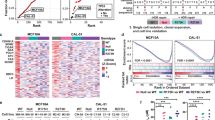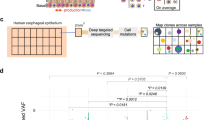Abstract
The p53 cellular tumour antigen, long known to be overproduced in a variety of neoplastically transformed cells1,2, was recently shown to be directly involved in transformation. Thus, p53 can complement activated Ha-ras in transforming secondary rat embryo fibroblasts into grossly altered, tumorigenic cells3,4. Moreover, p53 can also be shown to possess immortalizing activity5. Our previous results indicated, however, that the contribution of p53 to the transformation was not synonymous with immortalization, suggesting that the two activities of the protein are probably separable3. We demonstrate here that this is indeed the case, as overproduction of p53 in an established cell line, while not causing gross morphological changes, endows these cells with an overt tumorigenic potential. Furthermore, the tumorigenic efficiency of such cell lines may be correlated with the extent of p53 overproduction.
This is a preview of subscription content, access via your institution
Access options
Subscribe to this journal
Receive 51 print issues and online access
$199.00 per year
only $3.90 per issue
Buy this article
- Purchase on Springer Link
- Instant access to full article PDF
Prices may be subject to local taxes which are calculated during checkout
Similar content being viewed by others
References
Klein, G. (ed.) Advances in Viral Oncology Vol. 2 (Raven, New York, (1982).
Crawford, L. V. Int. Rev. exp. Path. 25, 1–50 (1983).
Eliyahu, D., Raz, A., Gruss, P., Givol, D. & Oren, M. Nature 312, 646–649 (1984).
Parada, L. F., Land, H., Weinberg, R. A., Wolf, D. & Rotter, V. Nature 312, 649–651 (1984).
Jenkins, J. R., Rudge, K. & Currie, G. A. Nature 312, 651–654 (1984).
Steinberg, B., Pollack, R., Topp, W. & Botchan, M. Cell 13, 19–32 (1978).
Mulligan, R. C. & Berg, P. Proc. natn. Acad. Sci. U.S.A. 78, 2072–2076 (1981).
Oren, M., Maltzman, W. & Levine, A. J. Molec. Cell Biol. 1, 101–110 (1981).
Mora, P. T., Chandrasekaran, K., Hoffmann, J. C. & McFarland, V. W. Molec. Cell Biol. 2, 763–771 (1982).
Keath, E. J., Caimi, P. G. & Cole, M. D. Cell 39, 339–348 (1984).
Bienz, B., Zakut-Houri, R., Givol, D. & Oren, M. EMBO J. 3, 2179–2183 (1984).
Pinhasi, O. & Oren, M. Molec. Cell Biol 4, 2180–2186 (1984).
Ellis, R. W. et al. J. Virol. 36, 408–420 (1980).
Laimins, L. A., Gruss, P., Pozzatti, R. & Khoury, G. J Virol 49, 183–189 (1984).
Rotter, V., Friedman, H., Katz, A., Zerivitz, K. & Wolf, D. J Immun. 131, 329–333 (1983).
Harlow, E., Crawford, L. V., Pirn, D. C. & Williamson, N. M. J Virol. 39, 861–869 (1981).
Galos, R. A., Williams, J., Binger, M. H. & Flint, S. J. Cell 17, 945–956 (1979).
Maniatis, T., Fritsch, E. F. & Sambrook, J. Molecular Cloning: A Laboratory Manual (Cold Spring Harbor Laboratory, New York, (1982).
Lehrach, H., Diamond, D., Wozney, J. M. & Boedtker, H. Biochemistry 16, 4743–4751 (1977).
Thomas, P. S. Proc. natn. Acad. Sci. U.S.A. 77, 5201–5205 (1980).
Zakut-Houri, R. et al. Nature 306, 594–597 (1983).
Oren, M., Bienz, D., Givol, D., Rechavi, G. & Zakut, R. EMBO J. 2, 1633–1639 (1983).
Author information
Authors and Affiliations
Rights and permissions
About this article
Cite this article
Eliyahu, D., Michalovitz, D. & Oren, M. Overproduction of p53 antigen makes established cells highly tumorigenic. Nature 316, 158–160 (1985). https://doi.org/10.1038/316158a0
Received:
Accepted:
Issue Date:
DOI: https://doi.org/10.1038/316158a0
This article is cited by
-
Shifting the paradigms for tumor suppression: lessons from the p53 field
Oncogene (2021)
-
Updates from the TP53 universe
Cell Death & Differentiation (2018)
-
The first 30 years of p53: growing ever more complex
Nature Reviews Cancer (2009)
-
Oncogenes do not Fully Override Cell-intrinsic Traits: Pronounced Impact of the Cellular Programme
Cancer Microenvironment (2009)
-
Transcription regulation by mutant p53
Oncogene (2007)
Comments
By submitting a comment you agree to abide by our Terms and Community Guidelines. If you find something abusive or that does not comply with our terms or guidelines please flag it as inappropriate.



